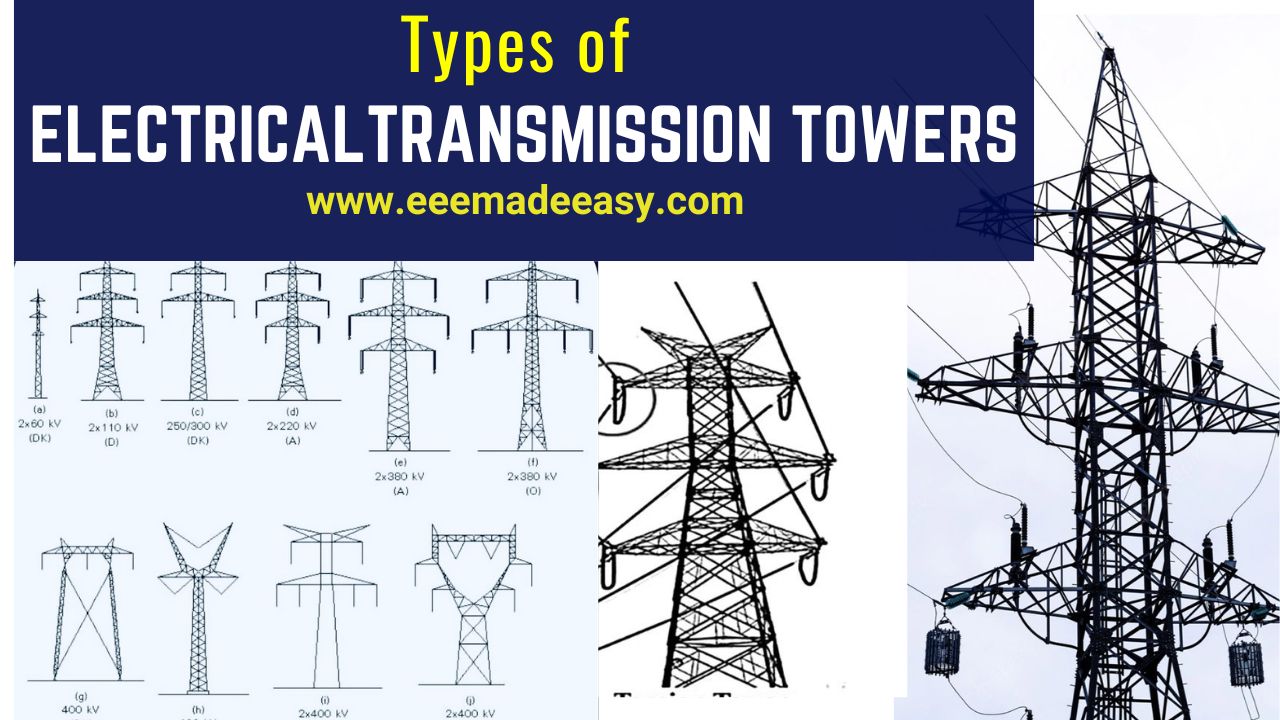In this post, you will learn the different types of Electrical transmission Towers in detail. You can also read about What is an Electrical transmission tower and parts of an Electric Tower, transmission line, and the different types of Transmission structure also.
Electrical Transmission Towers
Transmission towers/ Electric towers support the high-voltage conductors of overhead power lines, from the generating station to the source substations and satellite substations located near populated areas.
Read: Parts of a Power transmission line and Transmission tower|Transmission tower parts
Types of Electrical Transmission Towers
Based on different criteria there and different types of transmission towers.
- based on the angle of deviation
- based on the force applied by the conductor on the cross arms
- Based on the number of circuits carried by a transmission tower
- Based on Structure types
- based on the material used
- current types of towers
- current caring capacity in kV
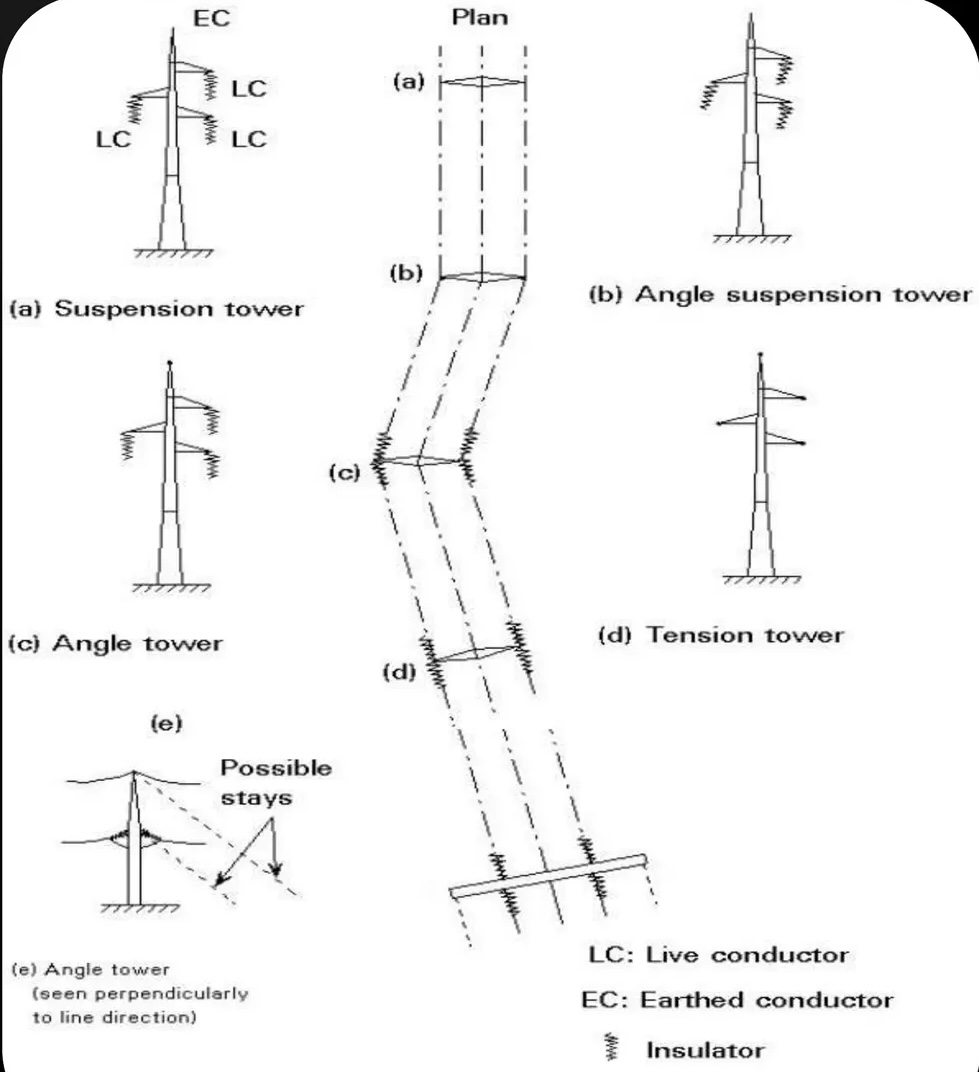
Electrical tower types based on the angle of deviation
Based on the angle of deviation, there are four types of transmission towers
- A-type tower ( 0o to 2o)
- B type tower (2o to 15o)
- C type tower (15° to 30°)
- D type tower (30° to 60o)
- E type tower (60o to 90o)
a) A-type tower
The angle of deviation is 0o to 2o for A-type towers. The type A Tower is a Tangent Tower with suspension string. it is used on straight runs and up to 2° line diversion.
b) B – type tower
The angle of deviation is 2o to 15o for B-type towers. Type B Tower is a Small Angle Tower with tension string it is used for line deviation from 2° to 15°.
c) C – type tower
The angle of deviation is 15o to 30o for C-type towers. Type C Tower is a Medium Angle Tower with tension string. it is used for line deviation from 15° to 30°.
d) D – type tower
The angle of deviation is 30o to 60o for D-type towers. Type D Tower is a Large angle tower with tension string. it is used for line deviation from 30° to 60o.
e) E – type tower
The angle of deviation is 60o to 90o for E-type towers. Type E Tower is a Dead End Tower with tension string. it is used for line termination & starting
Download & Install EEE Made Easy App
Electrical tower types that based on, the force applied by the conductor on the cross arms
As per the force applied by the conductor on the cross arms, the transmission towers can be categorized as ;
- Tangent suspension tower
- Angle tower or tension tower or Section tower
- special type tower
Tangent suspension tower
it is generally A – type tower.
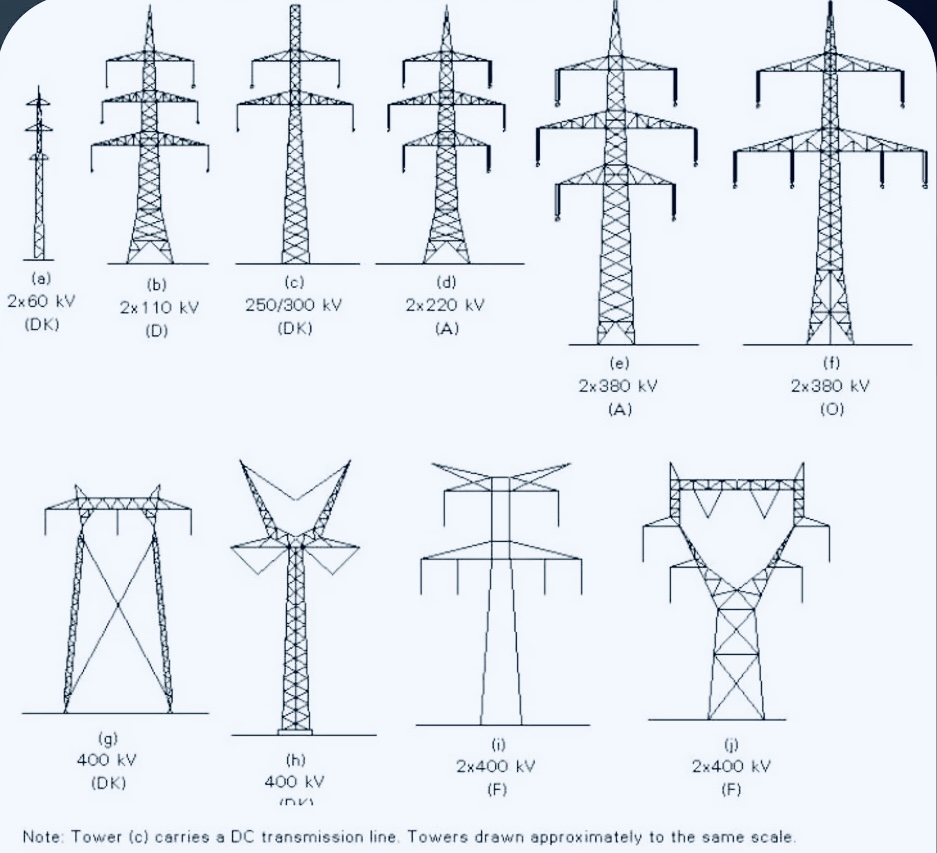
Angle tower or tension tower
or tension tower or sometimes it is called section tower. All B, C and D types of transmission towers come under this category.
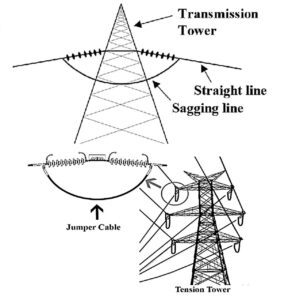
special type tower
Apart from the above-customized type of tower, this type of tower is designed to meet special usages listed below:
a) River crossing tower :
b) Railway/ Highway crossing tower:
c) Transposition tower:
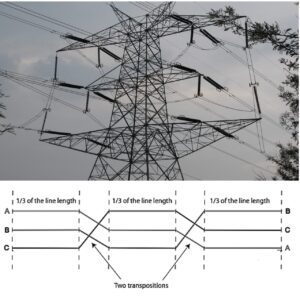
Electrical tower types based on the number of circuits
Based on the number of circuits carried by a transmission tower, it can be classified as
a) Single circuit tower
b) Double circuit tower
c) Multi – circuit tower
Single circuit tower
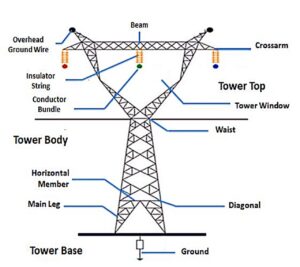
Double circuit tower
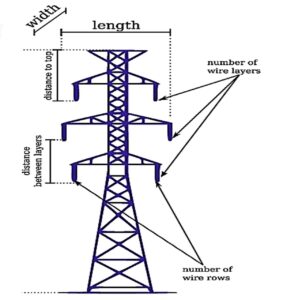
Multi – circuit tower
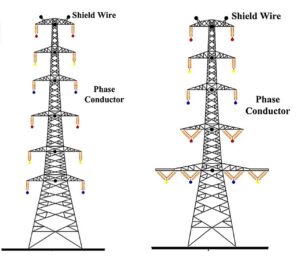
Electrical tower types based on the Structure types
Based on the Structure types of a transmission tower, it can be classified as
a) Lattice Structure
b) Hybrid Structure
c) Tubular Pole Structure
Electrical tower types based on the material used
Classification is forming the point of view of material used, it can be classified as-
a) Steel Structure
b) Wooden Material
c) RCC Pole
The supports for an overhead line must be capable of carrying the load due to Conductors,Insulators and Wind load on the support itself.
Steel Structure
Steel tubular poles & steel towers
Steel tubular poles: Stepped pole manufactured from a single tube , the diameter being reduced in parallel steps. these are more costly than RCC and wooden poles.
Steel tubular poles are light weight , have high strength to weight ratio and long life.
Steel tubular poles are used for lines upto 33kV
Steel towers: these are used for lines of 66kKV and above. Steel towers have very long life and a high degree of reliability. Steel towers can withstand very severe weather conditions.
Overhead HV, EHV, and UHV use self-supporting steel towers.
Wooden Poles tower
Wooden Poles are made of chemically treated wood.
these are used for distribution Fines, especially in areas where good quality wood are
available.
Wooden Poles towers are very economical but susceptible to decay.
To protect from decay, the poles have zinc or aluminum cap at the top and bottom
RCC Poles
RCC Pole towers are made of reinforced concrete cement.
RCC Poles are stronger than wooden poles but more costly.
RCC towers are having a very long life and need little maintenance.
But RCC Poles are bulky and heavy.
RCC Poles are widely used for distribution lines up to 33kV.
also, RCC Poles can be manufactured at sites.
Electrical tower types based on the current types
On the basis of current types of towers
a) HVAC transmission tower
b) HVDC transmission tower
c) Railway traction line tower
HVAC transmission tower
Three phase electric power systems are used for high voltage (66 or 69 kV and above) and extra-high voltage (110 or 115 kV and above; most often 138 or 230 kV and above in contemporary systems) AC transmission lines.
The towers must be designed to carry three(or multiples of three) conductors.
The towers are usually steel lattices or trusses (wooden structures are used in some cases) and the insulators are either glass or porcelain discs.
HVDC transmission tower
HVDC transmission lines are either monopolar or bipolar systems.
With bipolar systems, the conductor arrangement with one conductor on each side of the tower is used.
For single-pole HVDC transmission with ground return, towers with only one conductor can be used.
The towers are designed for later conversion to a two-pole system.
In these cases, often conductors n both sides of the tower are installed for mechanical reasons.
Railway traction line tower
in Railway traction, transmission lines are similar in construction to those towers used for 110 kV-three phase lines.
Steel tube or concrete poles are also often used for these lines.
The towers of railway traction lines carry two electric circuits, so they have four conductors.
Each circuit occupies one half of the cross arm. For six electric circuits arrangement of the conductors Is in three levels.
Electrical tower types based on the current carrying capacity in kV
On the basis of the current carrying capacity in kV, Transmission towers can be classified as,
a) 11 kV, b) 33 kV c) 66 kV d) 110 kV e) 132 kV f) 220 kV g) 400 kV h) 500 kV i) 765 kV j) 800 kV k) 1200 kV
Read Also
- Parts of a Power transmission line and Transmission tower|Transmission tower parts
- Transmission structures|Transmission towers and Transmission Poles|Electric Tower
- [MCQ Set 3]Electrical Power Generation, Transmission and Distribution MCQ Questions|EEE Made Easy
Latest Posts in EEE Made Easy
- Environment MCQ for RRB JE CBT 2|Objective Questions Environment for Competitive Exams
- RRB JE CBT 2 Computer Awareness Book Arihant|Objective Computer Awareness Book 2025
- RRB JE CBT 2 Exam Date 2025 Postponed|RRB JE CBT 2 Exam Date
- [PDF]RRB JE Result 03/2024 Cut off, Selected no of candidates for all regions
- [PDF]Final Answer Key Junior Instructor Mechanic Agricultural Machinery|643/2023 Solved Question paper
- Acoustics MCQs|Industries Extension officer|IEO 2025
- LASER MCQs| Industries Extension officer|IEO 2025
